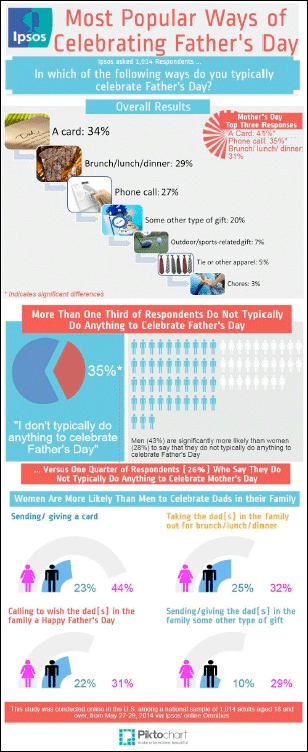Cards, Dining Out, and Phone Calls are the Top Three Ways America Celebrates Father’s Day
June 7, 2014
 Sending or giving cards to the dads in their family (34%) is the most common way US adults celebrate Father’s Day, according to a new survey of over 1,000 adults conducted by Ipsos Public Affairs. Three in ten also say that they take the dads in their families out for brunch, lunch, or dinner to celebrate Father’s Day (29%), while slightly more than a quarter celebrate by calling to wish the dad(s) a Happy Father’s Day (27%). Less than one in ten (7%) report that they usually send or give the dad(s) in the family an outdoor/sports-related gift, while few typically send or give a tie or other apparel (5%) or take care of chores that day like mowing the lawn or washing the car, to give dad(s) a break (3%). One in five (20%) celebrate by sending/giving the dad(s) in the family some other type of gift. However, the largest proportion of respondents, more than a third (35%), say that they do not typically do anything to celebrate Father’s Day.
Sending or giving cards to the dads in their family (34%) is the most common way US adults celebrate Father’s Day, according to a new survey of over 1,000 adults conducted by Ipsos Public Affairs. Three in ten also say that they take the dads in their families out for brunch, lunch, or dinner to celebrate Father’s Day (29%), while slightly more than a quarter celebrate by calling to wish the dad(s) a Happy Father’s Day (27%). Less than one in ten (7%) report that they usually send or give the dad(s) in the family an outdoor/sports-related gift, while few typically send or give a tie or other apparel (5%) or take care of chores that day like mowing the lawn or washing the car, to give dad(s) a break (3%). One in five (20%) celebrate by sending/giving the dad(s) in the family some other type of gift. However, the largest proportion of respondents, more than a third (35%), say that they do not typically do anything to celebrate Father’s Day.
 Women tend to be more likely than men to celebrate the dads in their family, particularly when it comes to sending cards (44% of women vs. 23% of men), taking the dads out for brunch/lunch/dinner (32% vs. 25%), calling (31% vs. 22%) or giving them some other type of gift (29% vs. 10%) for Father’s Day.
Women tend to be more likely than men to celebrate the dads in their family, particularly when it comes to sending cards (44% of women vs. 23% of men), taking the dads out for brunch/lunch/dinner (32% vs. 25%), calling (31% vs. 22%) or giving them some other type of gift (29% vs. 10%) for Father’s Day.
When comparing these results to those of a Mother’s Day survey conducted by Ipsos Public Affairs May 2-5, 2014, Mother’s Day is more widely celebrated than Father’s Day. A greater proportion of U.S. adults say that they don’t do anything to celebrate Father’s Day than say that they don’t celebrate Mother’s Day (35% vs. 26%, respectively).
Similarly, cards are more popular for celebrating Mother’s Day than Father’s Day (41% for moms vs. 34% for dads), as are phone calls (35% calling moms vs. 27% calling dads), or taking care of chores to give moms a break (8%) than to give dads a break (3%).
These are some of the findings of an Ipsos poll conducted May 27 – 29, 2014. For the survey, a national sample of 1,014 adults aged 18 and older from Ipsos’ U.S. online panel was interviewed online. Weighting was then employed to balance demographics and ensure that the sample’s composition reflects that of the U.S. adult population according to Census data and to provide results intended to approximate the sample universe. A survey with an unweighted probability sample of 1,014 and a 100% response rate would have an estimated margin of error of +/- 3.1 percentage points 19 times out of 20 of what the results would have been had the entire adult population of adults aged 18 and older in the United States had been polled. All sample surveys and polls may be subject to other sources of error, including, but not limited to coverage error, and measurement error.





























